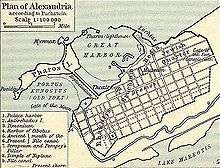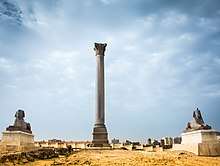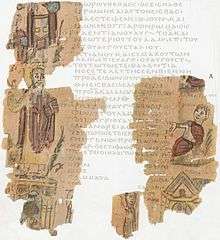Serapeum of Alexandria
The Serapeum of Alexandria in the Ptolemaic Kingdom was an ancient Greek temple built by Ptolemy III Euergetes (reigned 246–222 BCE) and dedicated to Serapis, who was made the protector of Alexandria. There are also signs of Harpocrates. It has been referred to as the daughter of the Library of Alexandria. The site has been heavily plundered.[1]


History
The site is located on a rocky plateau, overlooking land and sea.[1] By all detailed accounts, the Serapeum was the largest and most magnificent of all temples in the Greek quarter of Alexandria.
Besides the image of the god, the temple precinct housed an offshoot collection of the great Library of Alexandria.[2][3] The geographer Strabo tells that this stood in the west of the city.
Nothing now remains above ground, except the enormous Pompey's Pillar. According to Rowe and Rees 1956, accounts of Serapeum's still standing buildings they saw there have been left by Aphthonius, the Greek rhetorician of Antioch "who visited it about A.D. 315", and Rufinus, "a Christian who assisted at the destruction of [it] during the end of the fourth century"; the Pillar marks the "Acropolis" of the Serapeum in the account by Aphthonius, that is, "the upper part of the great Serapeum area".[1]
Closure of the Serapeum
The Serapeum of Alexandria was closed in July of 325 AD, likely on the orders of the Christian Emperor Constantine during the persecution of pagans in the late Roman Empire. Then, in 391 AD, religious riots broke out, according to Wace:[1]
The Serapeum was the last stronghold of the pagans who fortified themselves in the temple and its enclosure. The sanctuary was stormed by the Christians. The pagans were driven out, the temple was sacked, and its contents were destroyed. In this struggle the Library presumably perished also.

Destruction
The Serapeum in Alexandria was destroyed by a Christian mob or Roman soldiers in 391 (although the date is debated).[4] Several conflicting accounts for the context of the destruction of the Serapeum exist.
Whichever the cause, the destruction of the Serapeum, described by Christian writers Tyrannius Rufinus and Sozomen, was but the most spectacular of such conflicts, according to Peter Brown.[5] Several other ancient and modern authors, instead, have interpreted the destruction of the Serapeum in Alexandria as representative of the triumph of Christianity and an example of the attitude of the Christians towards pagans. However, Peter Brown frames it against a long-term backdrop of frequent mob violence in the city, where the Greek and Jewish quarters had fought during four hundred years, since the 1st century BCE.[6] Also, Eusebius mentions street-fighting in Alexandria between Christians and non-Christians, occurring as early as 249. There is evidence that non-Christians had taken part in citywide struggles both for and against Athanasius of Alexandria in 341 and 356. Similar accounts are found in the writings of Socrates of Constantinople. R. McMullan further reports that, in 363 (almost 30 years earlier), George of Cappadocia was killed for his repeated acts of pointed outrage, insult, and pillage of the most sacred treasures of the city.[7]
Whatever the prior events, the Serapeum of Alexandria was not rebuilt. After the destruction a monastery was established, a church was built for St. John the Baptist, known as Angelium or Evangelium. However, the church fell to ruins around 600 AD, restored by patriarch Isaac (681–684 AD), and finally destroyed in the 10th Century. More recently a Bab Sidra Moslem cemetery was located at the site.[1]
Christian version
According to early Christian sources, bishop Pope Theophilus of Alexandria was the Nicene patriarch when the decrees of emperor Theodosius I forbade public observances of any rites but Christian. Theodosius I had gradually made (year 389) the sacred feasts of other faiths into workdays, forbidden public sacrifices, closed temples, and colluded in acts of local violence by Christians against major cult sites. The decree promulgated in 391 that "no one is to go to the sanctuaries, [or] walk through the temples" resulted in the abandonment of many temples throughout the Empire, which set the stage for widespread practice of converting or replacing these sites with Christian churches.
In Alexandria, Bishop Theophilus obtained legal authority over one such forcibly abandoned temple of Dionysus (or, in another version of the story, a Mithraeum), which he intended to turn into a church. During the renovations, the contents of subterranean spaces ("secret caverns" in the Christian sources) were uncovered and profaned, which allegedly incited crowds of non-Christians to seek revenge. The Christians retaliated, as Theophilus withdrew, causing the pagans to retreat into the Serapeum, still the most imposing of the city's remaining sanctuaries, and to barricade themselves inside, taking captured Christians with them. These sources report that the captives were forced to offer sacrifices to the banned deities, and that those who refused were tortured (their shins broken) and ultimately cast into caves that had been built for blood sacrifices. The trapped pagans plundered the Serapeum (Rufinus & MacMullen 1984).
A letter was sent by Theodosius to Theophilus, asking him to grant the offending pagans pardon and calling for the destruction of all pagan images, suggesting that these were at the origin of the commotion. Consequently, the Serapeum was levelled by Roman soldiers and monks called in from the desert, as were the buildings dedicated to the Egyptian god Canopus. The wave of destruction of non-Christian idols spread throughout Egypt in the following weeks, as documented by a marginal illustration on papyrus from a world chronicle written in Alexandria in the early 5th century, which shows Theophilus in triumph (illustration, above left); the cult image of Serapis, crowned with the modius, is visible within the temple at the bottom.[8]
Pagan version
An alternate account of the incident is found in Lives of the Philosophers and Sophists (LCL vol. 134, pp. 416-425) by Eunapius, the pagan historian of later Neoplatonism. Here, an unprovoked Christian mob successfully used military-like tactics to destroy the Serapeum and steal anything that may have survived the attack. According to Eunapius, the remains of criminals and slaves, who had been occupying the Serapeum at the time of the attack, were appropriated by Christians, placed in (surviving) pagan temples, and venerated as martyrs.[9][10]
Sozomen's account
About this period, the bishop of Alexandria, to whom the temple of Dionysus had, at his own request, been granted by the emperor, converted the edifice into a church. The statues were removed, the adyta (hidden statues) were exposed; and, in order to cast contumely on the pagan mysteries, he made a procession for the display of these objects; the phalli (ritual symbols of Dionysus), and whatever other object had been concealed in the adyta which really was, or seemed to be, ridiculous, he made a public exhibition of.
The pagans, amazed at so unexpected an exposure, could not suffer it in silence, but conspired together to attack the Christians. They killed many of the Christians, wounded others, and seized the Serapion, a temple which was conspicuous for beauty and vastness and which was seated on an eminence. This they converted into a temporary citadel; and hither they conveyed many of the Christians, put them to the torture, and compelled them to offer sacrifice. Those who refused compliance were crucified, had both legs broken, or were put to death in some cruel manner. When the sedition had prevailed for some time, the rulers came and urged the people to remember the laws, to lay down their arms, and to give up the Serapion. There came then Romanus, the general of the military legions in Egypt; and Evagrius was the prefect of Alexandria.
As their efforts, however, to reduce the people to submission were utterly in vain, they made known what had transpired to the emperor.
Those who had shut themselves up in the Serapion prepared a more spirited resistance, from fear of the punishment that they knew would await their audacious proceedings, and they were further instigated to revolt by the inflammatory discourses of a man named Olympius, attired in the garments of a philosopher, who told them that they ought to die rather than neglect the gods of their fathers. Perceiving that they were greatly dispirited by the destruction of the idolatrous statues, he assured them that such a circumstance did not warrant their renouncing their religion; for that the statues were composed of corruptible materials, and were mere pictures, and therefore would disappear; whereas, the powers which had dwelt within them, had flown to heaven. By such representations as these, he retained the multitude with him in the Serapion.
When the emperor was informed of these occurrences, he declared that the Christians who had been slain were blessed, inasmuch as they had been admitted to the honor of martyrdom, and had suffered in defense of the faith.
He offered free pardon to those who had slain them, hoping that by this act of clemency they would be the more readily induced to embrace Christianity; and he commanded the demolition of the temples in Alexandria which had been the cause of the popular sedition.
It is said that, when this imperial edict was read in public, the Christians uttered loud shouts of joy, because the emperor laid the odium of what had occurred upon the pagans.
The people who were guarding the Serapion were so terrified at hearing these shouts, that they took to flight, and the Christians immediately obtained possession of the spot, which they have retained ever since.
I have been informed that, on the night preceding this occurrence, Olympius heard the voice of one singing hallelujah in the Serapion. The doors were shut and everything was still; and as he could see no one, but could only hear the voice of the singer, he at once understood what the sign signified; and unknown to any one he quitted the Serapion and embarked for Italy. It is said that when the temple was being demolished, some stones were found, on which were hieroglyphic characters in the form of a cross, which on being submitted to the inspection of the learned, were interpreted as signifying the life to come. These characters led to the conversion of several of the pagans, as did likewise other inscriptions found in the same place, and which contained predictions of the destruction of the temple.
It was thus that the Serapion was taken, and, a little while after, converted into a church; it received the name of the Emperor Arcadius.
(Sozomen, Historia Ecclesiastica, 7: 15)Rufinus' account
One of the soldiers, better protected by faith than by his weapon, grabs a double-edged axe, steadies himself and, with all his might, hits the jaw of the old statue. Hitting the worm-eaten wood, blackened by the sacrificial smoke, many times again, he brings it down piece by piece, and each is carried to the fire that someone else has already started, where the dry wood vanishes in flames. The head goes down, then the feet are hacked, and finally the god's limbs are ripped from the torso with ropes. And so it happens that, a piece at a time, the senile buffoon is burned right in front of its adorer, Alexandria. The torso, which had remained unscathed, was burned in the amphitheatre, in a final act of contumely. [...]
A brick at a time, the building is taken apart by the righteous (sic) in the name of our Lord God: the columns are broken, the walls knocked down. The gold, the fabrics and precious marbles are removed from the impious stones imbued with the devil. [...]
The temple, its priests and the wicked sinners are now vanquished and relegated to the flames of hell, as the vain superstition (paganism) and the ancient demon Serapis are finally destroyed.
- Tyrannius Rufinus, Historia ecclesiastica, 2: 23Excavations
.jpg)
Architecture has been traced to an early Ptolemaic and a second Roman period.[1] The excavations at the site of the column of Diocletian in 1944 yielded the foundation deposits of the Serapeion. These are two sets of ten plaques, one each of gold, silver, bronze, Egyptian faience, sun-dried Nile mud, and five of opaque glass.[11] The inscription that Ptolemy III Euergetes built the Serapeion, in Greek and Egyptian, marks all plaques; evidence suggests that Parmeniskos (Parmenion) was assigned as architect.[12]
The foundation deposits of a temple dedicated to Harpocrates from the reign of Ptolemy IV Philopator were also found within the enclosure walls.[13]
Signs point to a first destruction during the Kitos War in 116 AD. It has been suggested it was then rebuild under Hadrian.[1] This is supported with the 1895 find of a black diorite statue, representing Serapis in his Apis bull incarnation with the sun disk between his horns; an inscription dates it to the reign of Hadrian (117–138).
It has also been suggested that there was worship of the goddess of health, marriage, and wisdom Isis.[1] Subterranean galleries beneath the temple were most probably the site of the mysteries of Serapis. Granite columns suggest a Roman rebuilding and widening of the Alexandrine Serapeum in AD 181–217. Excavations recovered 58 bronze coins, and 3 silver coins, with dates up to 211.[14] The torso of a marble statue of Mithras was found in 1905/6.[1]
Statues
According to fragments, there were statues of the twelve gods. Mimaut mentioned in the 19th century, nine standing statues holding rolls, which would coincident with the nine goddesses of the arts, reportedly present at the Library of Alexandria.[15] Eleven statues were found at Saqqara. A review of "Les Statues Ptolémaïques du Sarapieion de Memphis" noted they were probably sculpted in the 3rd century with limestone and stucco, some standing others sitting. Rowe and Rees 1956 suggested that both scenes in the Serapeum of Alexandria and Saqqara, share a similar theme, such as with Plato's Academy mosaic, with Saqqara figures attributed to: "(1) Pindare, (2) Démétrios de Phalère, (3) x (?), (4) Orphée (?) aux oiseaux, (5) Hésiode, (6) Homère, (7) x (?), (8) Protagoras, (9) Thalès, (10) Héraclite, (11) Platon, (12) Aristote (?)."[1][16]
Ammianus Marcellinus, Res Gestae, XXII, 16
References
- Alan Rowe and B. R. Rees (1956). "A Contribution To The Archaeology of The Western Desert: IV - The Great Serapeum Of Alexandria" (PDF). Manchester.CS1 maint: uses authors parameter (link)
- Sabottka, M. (1986). Das Serapeum in Alexandria. Paper presented at the Koldeway-Gesellschaft, Bericht über die 33. Tagung für Ausgrabungswissenschaft und Bauforschung 30. Mai-30. Juni 1984.
- Sabottka, M. (1989). Das Serapeum in Alexandria. Untersuchungen zur Architektur und Baugeschichte des Heiligtums von der frühen ptolemäischen Zeit bis zur Zerstörung 391 n. Chr., Dissertation, University of Berlin.
- Hahn: Gewalt und religiöser Konflikt. p.82.
- The Rise of Western Christendom (2003: 73-74.
- Kreich, Chapter 4 Archived 2010-05-31 at the Wayback Machine, Michael Routery, 1997.
- Ramsay McMullan, Christianizing the Roman Empire A.D. 100-400 (Yale University Press) 1984: 90.
- (MacMullen 1984)
- Cox Miller, Patricia (2000). "10. Strategies of Representation in Collective Biography: Constructing the Subject as Holy". In Hägg, Tomas; Rousseau, Philip (eds.). Greek Biography and Panegyric in Late Antiquity. With the assistance of Christian Høgel. University of California Press. pp. 222–3.
- (Turcan, 1996)
- Kessler, D. (2000). Das hellenistische Serapeum in Alexandria und Ägypten. Paper presented at the Ägypten und der östliche Mittelmeerraum im 1. Jahrtausend v. Chr. conference, Berlin.
- McKenzie, J. (2007). The Architecture of Alexandria and Egypt, C. 300 B.C. to A.D. 700: Yale University Press.
- McKenzie, J. S., Gibson, S., & Reyes, A. T. (2008). Reconstructing the Serapeum in Alexandria from the Archaeological Evidence.
- Judith McKenzie, "Glimpsing Alexandria from archaeological evidence"; Journal of Roman Archaeology Vol. 16 (2003), pp. 50–56. "The Roman version of the Serapeum, which was larger, was built between 181 and 217. Concrete foundations and parts of granite columns survive from this phase. The concrete foundations enclose the foundations of the ashlar walls of the Ptolemaic temple, following the Egyptian custom. [...] Foundation deposits of coins were found embedded in the corners of the pool near the E entrance, 'the floor of the pool being of exactly the same material as the foundations of the Roman temple itself'. The latest coin is dated to 211 and provides a terminus post quem the pool and an indication of the date of construction of the Roman temple."
- Murray, S. A., (2009). The library: An illustrated history. New York: Skyhorse Publishing, p. 17
- Ph. Lauer and Ch. Picard (1957). "Reviewed Work: Les Statues Ptolémaïques du Sarapieion de Memphis". Archaeological Institute of America. doi:10.2307/500375. JSTOR 500375.CS1 maint: uses authors parameter (link)
External links

- Rufinus – "The Destruction of the Serapeum A.D. 391"
- Richard Stillwell, ed. Princeton Encyclopedia of Classical Sites, 1976: "Alexandria, Egypt: Serapeion"